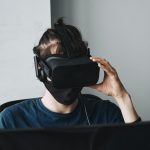2020 was an immensely difficult time for businesses, so what can you do in 2021 to better your team? One should look more in-depth into internal factors such as employee training performance, efficient productivity, or a lack of group communication that are adding to the mix of decreased profits. With increased globalisation and an influx of competition on the high rise, CEO’s must review and update their internal processes as these could be partially stagnating a company’s growth.
With the help of groundbreaking VR technology, new and existing employees, can be trained in a motivated environment that builds sustainable solutions to upskill team performance in the workplace everyday. To come to an ultimate decision on whether you should invest in the market’s most sustainable and extraordinary training solution, this article will sum up key points to help you decide if VR training is the right choice for your business.
Training at scale, and designed for complex and experienced-based Professions
VR training opens a gateway of opportunity when it comes to content creation. Mandatory training programs replicate workplace environments through 360 interactive video or CGI (computer generated imagery). VR exposes employees to challenging scenarios, making it suitable for workers in hospitality and retail professions. 360 video is used to provide ongoing training that can aid in sales development and facilitate improved interactions with customers. From learning how to make salads at a fast food eatery, to learning how to manage an intoxicated person at a bar, VR accesses a worker in any and every scenario in order to optimise positive consumer feedback, improve skills and facilitate progress that will enable employees the confidence to attract repeat customers.
By contrast, CGI is highly beneficial for industries that have a high reliance on manual work. Immersions are extremely lifelike, making it worthwhile for medical and mechanical professions to use as part of learning and development. CNBC discusses how Canada’s Queens University and SimforHealth have integrated VR training so that trainees can make beginner mistakes in Virtual reality, rather than on actual patients. Practicing simulations in VR is harmless to the user and the user’s environment, yet it also frees up valuable and expensive resources, making it cost-effective.
Provided that training only requires the user and a VR headset, the process is seamless. No longer do you need to train each employee multiple times across incremented sessions, as VR is a scalable, individualised technology that eliminates monitoring training (that can come at a high cost). There’s no need to stress over setting up equipment or booking external tailored training experiences that only take place on an annual basis, as these environments can be replicated in the 3D and repeated to reach a large team of workers far more often than traditional training ever would allow.
Training can be made to accommodate to different branches within your company and tracked by data performance
If your company needs tailored training for various departments, VR training offers a versatile soft-ware based solution. According to HRdrive, The US department of Defense uses VR training that is split across different branches of the military. Each branch must undergo core training modules, however tasks militants are required to practice differ depending on a teams location and other pending factors. VR organises modules onto one platform so that each team can choose their training and have performance tracking analytics provide results on users progress. These metrics are used for business owners to distinguish how regular training should occur and what tasks need to be more urgently prioritised.
Another advantage of VR data tracking, is how helpful it can be for business owners to grasp what training may need to be changed or updated. VR technology is able to capture intricate details that could prove beneficial to many industries. For example, it can track hand and eye movements to see how workers went about various processes and where they fell short in their delivery. This would suit just about any field or line of work, from simple service tasks to complex surgeries or emergency evaluation services. Unlike live-training, VR sets apart each individual’s performance using soft metrics and hard metrics that serve vital roles in acquiring optimal results. Provided you have the support of your companies HR, IT and high senior management to build, test and fund training, VR is flexible in adapting with new regimes and immersive to ensure workers constantly gain a new perspective on expectations that will see them through to success.
To summarise, VR training provides the building blocks to excel in new skills at a faster rate than any other form of regular training, so that the employee can proceed quickly and embody their full potential in the workplace. Training in virtual reality is suited for larger businesses seeking a more structured, tailored, safe and in-depth use of training that can be accessed more frequently. Employees can choose a convenient time to complete training modules with greater focus and intent for learning.
If you want your business to stay ahead of the curve, reach out to YesVR to see what we can do for your team.
Written by Lauren Tizzone
Similar articles to check out:







